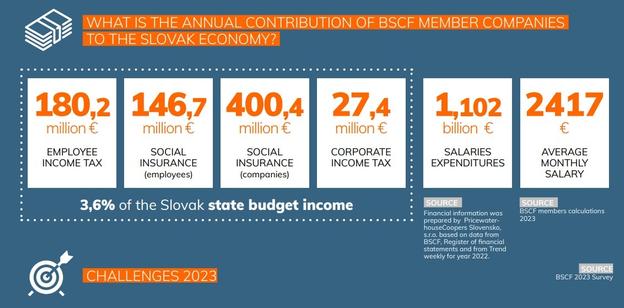Business service centres have created one of the most important and stable sectors of the Slovak economy. According to Peter Rusiňák, from the AmCham Business Service Center Forum, this is a ‘sector of the future’, the potential of which Slovakia has not yet exhausted.
But part of society does not know much about the sector even today.
“This sector ‘suffers’ from the fact that, unlike the automotive industry, it does not produce nor own any material goods. But you have many nice examples of why this sector is unique,” says Rusiňák.
The AmCham Business Service Center Forum (BSCF) has been helping to raise awareness of the sector for 10 years.
The business service centres (BSC) sector is said to be the second or third strongest in the Slovak economy. So, is it second or third?
The BSC sector is the most stable sector of the economy. It is the third largest in terms of contributions to the state budget. I’m not exaggerating when I say that roughly 40,000 employees contribute almost 4 percent to the running of this country in terms of income. It is the third largest after the automotive and electrical engineering industries. Of course, there are sectors in Slovakia that are larger in terms of number of employees.
These centres have been operating in Slovakia since the nineties. How many are there today?
Overall, for the number of companies, we usually state that there are between 60 and 65 business service centres in Slovakia. Thirty-nine companies, which together employ 95 percent of all employees in the sector, are members of the AmCham Business Service Center Forum. When we founded the BSCF 10 years ago, the companies that helped to establish it were mostly giants. Each employed several thousand people. Together, these centres employed roughly 20,000 people. However, such companies stopped coming here in 2010. Instead, many companies that employ 200, 400, or maybe 500 people started arriving.
When you say that 40,000 people work in the BSC sector, is that a number that you and the state agree on?
The state itself does not monitor the number of workers in the sector, it draws data from us. And that, for example, is one of the challenges we face. When you click on the website of the Statistics Office, you will not find any mention that there are positions in business service centres. For example, when we try to communicate with labour offices and want to tell them what types of positions are in short supply on the Slovak market, we have to use codes relevant for some other types of positions. Some do overlap, but you can’t officially assign them to business service centres.
For the country’s better overview of what kind of people work in the sector, the taxes they pay, what their work means for the Slovak economy, it would be very helpful if the Statistics Office identified that this is a separate sector of the economy. But this is not only Slovakia’s problem.
I assume that the state knows about it and is working to change it?
I highly wish for it. But it’s important to say that there are institutions like the Economy Ministry that have a very good overview of the BSC sector and understand it. On the contrary, the Statistics Office, district offices and municipalities are still not completely familiar with what these centres do. The Statistics Office is perhaps not even the first institution that should solve this problem.
For a long time, we have been communicating these things to the Central Office for Labour, Social Affairs and Family, especially when we try to identify for them the long-term shortage of positions in the regions of Slovakia. The feedback from the Office was that they understand our problem and that they are trying to solve it together with the problems of other sectors. But I don’t feel that there is an effort towards an individual approach. It’s more about trying to find one approach for the whole economy. For that matter, it might not be quite what we all need.
Who is to blame for the fact that the BSC sector is not recognised by people in the same way as, for example, the automotive industry?
It’s a very good question. I certainly wouldn’t go seeking a specific culprit. Our approach is different. We ask what we can do together to improve the branding of these companies and the sector.
Yes, this sector ‘suffers’ from the fact that, unlike the automotive industry, it does not produce any material goods. But you have a lot of nice examples of why this sector is unique. In Košice, for example, people operate oil towers in the Persian Gulf, because they developed software for that, controlled from Košice. In addition, the sector is growing not only quantitatively, but also qualitatively in the typology of job positions we have in Slovakia. The job positions are significantly different from what these companies came here with 20 years ago. They are far from repetitive; the centres need people who think more.
Okay, but how do you promote your activities? BSCF has not been very active on social networks until now.
Our long-term plan to attract people to the BSC sector is to actively work with schools. We have long-term cooperation with those fields of study that are key to the skills these companies need. Young people thus have the opportunity to get to know companies already during their studies and work on interesting and innovative projects as part of their education.
This is important for us. But I agree with you that more can always be done in regards to social media promotion.



